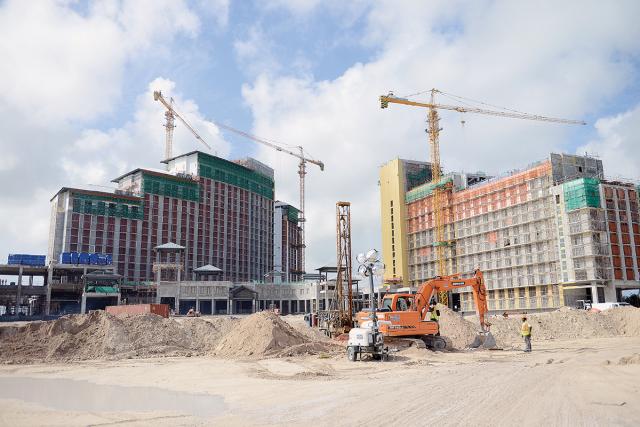 The Bahamas is home to the Caribbean’s largest hotel project ever planned — the $3.5 billion Baha Mar development on the south shore of New Providence Island.
The Bahamas is home to the Caribbean’s largest hotel project ever planned — the $3.5 billion Baha Mar development on the south shore of New Providence Island.
The mammoth resort is about halfway completed and will open on schedule in December 2014, said Robert Sands, senior vice-president of administration and external affairs. A midway “topping off” celebration marked completion of the 25th and final level of the Baha Mar Casino & Hotel, the tallest structure at the 1,000-acre resort.
Baha Mar will include four new hotels — a Mondrian, a Rosewood, a Grand Hyatt and a casino hotel — as well as a convention center and Jack Nicklaus’ golf course. It’s being marketed as the Bahamian Riviera and will encompass the existing Sheraton and Wyndham hotels and boast 2,200 rooms.
While the Bahamas encompasses 700 islands, the most frenetic development is taking place on New Providence Island, home to the capital city, Nassau.
“The Bahamas is experiencing a more aggressive turnaround due to the recent revitalization of Nassau, which has been fast-tracked as an accessible, modern and luxurious vacation and second-home destination,” said Gustaf Hernqvist, sales and marketing VP at the oceanfront Caves Heights condo project in Nassau.
In the first quarter of 2013 alone, Caves Heights sold 10 units worth $9 million; three-bedroom units, ranging in value from $800,000 to $1 million, have proven to be the top sellers, with few remaining.
This year, the Bahamas will rake in more than $13 million and gain some 20,000 hotel room nights from sports tourism alone — with two international soccer events in May boosting the nation’s profile worldwide. The two events, both held at the Atlantis resort on Paradise Island, are the FIFA Beach Soccer World Cup qualifier and the English Premiere League soccer exhibition at the national stadium between Great Britain and Jamaica.
In addition to one of the Caribbean’s biggest resorts, the Bahamas also has a world-class international airport to boast about. But who will foot the bill for this strikingly modern, $409.5 million expansion project remains a matter of controversy.
The three-stage redevelopment of Nassau’s Lynden Pindling International Airport (LPIA) began with the March 2011 opening of a 247,000-square-foot U.S. terminal and one million square feet of aircraft operating surface. The second stage, a 226,000-square-foot international arrivals terminal valued at $144 million and housing more than 20 retail and food outlets, was inaugurated in October 2012.
Upon completion of Phase III — consisting of a domestic and international departures terminal as well as a domestic arrivals terminal — later this year, the new LPIA airport complex will cover 571,000 square feet and have the capacity to handle five million passengers per year.
To pay for it all, the Nassau Airport Development Co. (NAD) has proposed boosting the international passenger facility charge by $4.50 and the domestic passenger facility charge by $2.50, effective Oct. 1, 2013. This will raise the total fee to $40 for international passengers.
But that doesn’t sit well with the seven airlines that bring the bulk of U.S. passengers to the Bahamas: American, US Airways, Delta, JetBlue, Southwest, Spirit and United. In a Feb. 4 letter to NAD, the airlines complained that the proposed increase would unfairly raise the cost of air travel and cut into profits of airlines serving the competitive Bahamas tourism market.
In response, the airport’s governing body is aggressively defending its action, arguing that all passenger facility charge (PFC) increases are made in accordance with initial plans discussed with the airlines when LPIA’s expansion commenced in 2009.
“PFC increases have been timed to occur at the end of each stage of construction, as each new terminal commences operation, at the airlines’ request,” said Chris Ryan, NAD’s vice-president and chief financial officer, in his Feb. 19. letter. “This means financing for construction was raised in advance, with debt repayment deferred, until full operations of the new terminal commenced.”
Based on traffic forecasts, Ryan said, the current rates will repay the debt with only CPI-based increases in the future. “The nature of the financing of this project is such that essentially all of the free cash flow of the airport must be utilized to first repay the debt.”
In 2012, LPIA handled 731,312 domestic, 362,260 non-U.S. international and 2,175,706 U.S. passengers for a grand total of nearly 3.27 million. That’s up 5 percent over 2011 figures and represents increases in all sectors.
By Larry Luxner
Baltimore Post-Examiner



